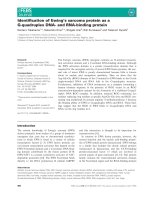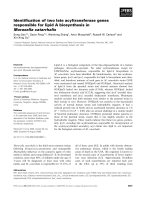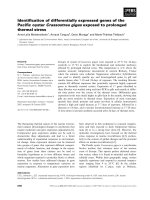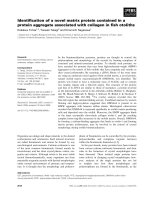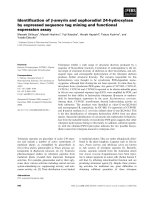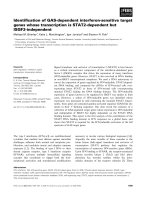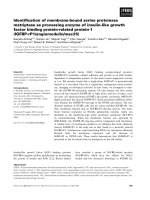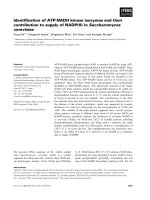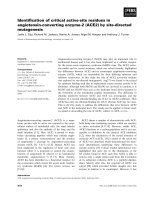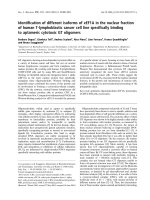Báo cáo khoa học: "Identification of Domain-Specific Senses in a Machine-Readable Dictionary" potx
Bạn đang xem bản rút gọn của tài liệu. Xem và tải ngay bản đầy đủ của tài liệu tại đây (118.39 KB, 6 trang )
Proceedings of the 49th Annual Meeting of the Association for Computational Linguistics:shortpapers, pages 552–557,
Portland, Oregon, June 19-24, 2011.
c
2011 Association for Computational Linguistics
Identification of Domain-Specific Senses in a Machine-Readable Dictionary
Fumiyo Fukumoto
Interdisciplinary Graduate School of
Medicine and Engineering,
Univ. of Yamanashi
Yoshimi Suzuki
Interdisciplinary Graduate School of
Medicine and Engineering,
Univ. of Yamanashi
Abstract
This paper focuses on domain-specific senses
and presents a method for assigning cate-
gory/domain label to each sense of words in
a dictionary. The method first identifies each
sense of a word in the dictionary to its cor-
responding category. We used a text classifi-
cation technique to select appropriate senses
for each domain. Then, senses were scored by
computing the rank scores. We used Markov
Random Walk (MRW) model. The method
was tested on English and Japanese resources,
WordNet 3.0 and EDR Japanese dictionary.
For evaluation of the method, we compared
English results with the Subject Field Codes
(SFC) resources. We also compared each En-
glish and Japanese results to the first sense
heuristics in the WSD task. These results
suggest that identification of domain-specific
senses (IDSS) may actually be of benefit.
1 Introduction
Domain-specific sense of a word is crucial informa-
tion for many NLP tasks and their applications, such
as Word Sense Disambiguation (WSD) and Informa-
tion Retrieval (IR). For example, in the WSD task,
McCarthy et al. presented a method to find predom-
inant noun senses automatically using a thesaurus
acquired from raw textual corpora and the Word-
Net similarity package (McCarthy et al., 2004; Mc-
Carthy et al., 2007). They used parsed data to find
words with a similar distribution to the target word.
Unlike Buitelaar et al. approach (Buitelaar and
Sacaleanu, 2001), they evaluated their method us-
ing publically available resources, namely SemCor
(Miller et al., 1998) and the SENSEVAL-2 English
all-words task. The major motivation for their work
was similar to ours, i.e., to try to capture changes in
ranking of senses for documents from different do-
mains.
Domain adaptation is also an approach for fo-
cussing on domain-specific senses and used in the
WSD task (Chand and Ng, 2007; Zhong et al., 2008;
Agirre and Lacalle, 2009). Chan et. al. proposed
a supervised domain adaptation on a manually se-
lected subset of 21 nouns from the DSO corpus hav-
ing examples from the Brown corpus and Wall Street
Journal corpus. They used active learning, count-
merging, and predominant sense estimation in order
to save target annotation effort. They showed that
for the set of nouns which have different predomi-
nant senses between the training and target domains,
the annotation effort was reduced up to 29%. Agirre
et. al. presented a method of supervised domain
adaptation (Agirre and Lacalle, 2009). They made
use of unlabeled data with SVM (Vapnik, 1995),
a combination of kernels and SVM, and showed
that domain adaptation is an important technique for
WSD systems. The major motivation for domain
adaptation is that the sense distribution depends on
the domain in which a word is used. Most of them
adapted textual corpus which is used for training on
WSD.
In the context of dictionary-based approach, the
first sense heuristic applied to WordNet is often used
as a baseline for supervised WSD systems (Cotton et
al., 1998), as the senses in WordNet are ordered ac-
cording to the frequency data in the manually tagged
resource SemCor (Miller et al., 1998). The usual
552
drawback in the first sense heuristic applied to the
WordNet is the small size of the SemCor corpus.
Therefore, senses that do not occur in SemCor are
often ordered arbitrarily. More seriously, the deci-
sion is not based on the domain but on the frequency
of SemCor data. Magnini et al. presented a lexi-
cal resource where WordNet 2.0 synsets were anno-
tated with Subject Field Codes (SFC) by a procedure
that exploits the WordNet structure (Magnini and
Cavaglia, 2000; Bentivogli et al., 2004). The results
showed that 96% of the WordNet synsets of the noun
hierarchy could have been annotated using 115 dif-
ferent SFC, while identification of the domain labels
for word senses was required a considerable amount
of hand-labeling.
In this paper, we focus on domain-specific
senses and propose a method for assigning cate-
gory/domain label to each sense of words in a dictio-
nary. Our approach is automated, and requires only
documents assigned to domains/categories, such as
Reuters corpus, and a dictionary with gloss text,
such as WordNet. Therefore, it can be applied easily
to a new domain, sense inventory or different lan-
guages, given sufficient documents.
2 Identification of Domain-Specific Senses
Our approach, IDSS consists of two steps: selection
of senses and computation of rank scores.
2.1 Selection of senses
The first step to find domain-specific senses is to se-
lect appropriate senses for each domain. We used
a corpus where each document is classified into do-
mains. The selection is done by using a text classi-
fication technique. We divided documents into two
sets, i.e., training and test sets. The training set is
used to train SVM classifiers, and the test set is to
test SVM classifiers. For each domain, we collected
noun words. Let D be a domain set, and S be a set
of senses that the word w ∈ W has. Here, W is a set
of noun words. The senses are obtained as follows:
1. For each sense s ∈ S, and for each d ∈ D,we
applied word replacement, i.e., we replaced w
in the training documents assigning to the do-
main d with its gloss text in a dictionary.
2. All the training and test documents are tagged
by a part-of-speech tagger, and represented as
term vectors with frequency.
3. The SVM was applied to the two types of train-
ing documents, i.e., with and without word re-
placement, and classifiers for each category are
generated.
4. SVM classifiers are applied to the test data. If
the classification accuracy of the domain d is
equal or higher than that without word replace-
ment, the sense s of a word w is judged to be a
candidate sense in the domain d.
The procedure is applied to all w ∈ W .
2.2 Computation of rank scores
We note that text classification accuracy used in se-
lection of senses depends on the number of words
consisting gloss in a dictionary. However, it is not
so large. As a result, many of the classification ac-
curacy with word replacement were equal to those
without word replacement
1
. Then in the second pro-
cedure, we scored senses by using MRW model.
Given a set of senses S
d
in the domain d, G
d
=
(S
d
, E) is a graph reflecting the relationships be-
tween senses in the set. Each sense s
i
in S
d
is a
gloss text assigned from a dictionary. E is a set of
edges, which is a subset of S
d
× S
d
. Each edge e
ij
in E is associated with an affinity weight f (i → j)
between senses s
i
and s
j
(i = j). The weight is com-
puted using the standard cosine measure between
two senses. The transition probability from s
i
to
s
j
is then defined by normalizing the corresponding
affinity weight p(i → j) =
f(i→j)
P
|S
d
|
k=1
f(i→k)
,ifΣf =0,
otherwise, 0.
We used the row-normalized matrix U
ij
=
(U
ij
)
|S
d
|×|S
d
|
to describe G with each entry corre-
sponding to the transition probability, where U
ij
=
p(i → j). To make U a stochastic matrix, the rows
with all zero elements are replaced by a smooth-
ing vector with all elements set to
1
|S
d
|
. The matrix
form of the saliency score Score(s
i
) can be formu-
lated in a recursive form as in the MRW model:
λ
= μU
T
λ +
(1−µ)
|S
d
|
e, where
λ = [Score(s
i
)]
|S
d
|×1
is a vector of saliency scores for the senses. e is a
column vector with all elements equal to 1. μ is a
1
In the experiment, the classification accuracy of more than
50% of words has not changed.
553
damping factor. We set μ to 0.85, as in the PageR-
ank (Brin and Page, 1998). The final transition ma-
trix is given by the formula (1), and each score of the
sense in a specific domain is obtained by the princi-
pal eigenvector of the new transition matrix M .
M = μU
T
+
(1 − μ)
| S
d
|
ee
T
(1)
We applied the algorithm for each domain. We
note that the matrix M is a high-dimensional space.
Therefore, we used a ScaLAPACK, a library of
high-performance linear algebra routines for dis-
tributed memory MIMD parallel computing (Netlib,
2007)
2
. We selected the topmost K% senses accord-
ing to rank score for each domain and make a sense-
domain list. For each word w in a document, find
the sense s that has the highest score within the list.
If a domain with the highest score of the sense s and
a domain in a document appearing w match, s is re-
garded as a domain-specific sense of the word w.
3 Experiments
3.1 WordNet 3.0
We assigned Reuters categories to each sense of
words in WordNet 3.0
3
. The Reuters documents
are organized into 126 categories (Rose et al., 2002).
We selected 20 categories consisting a variety of
genres. We used one month of documents, from
20th Aug to 19th Sept 1996 to train the SVM model.
Similarly, we classified the following one month of
documents into these 20 categories. All documents
were tagged by Tree Tagger (Schmid, 1995).
Table 1 shows 20 categories, the number of train-
ing and test documents, and F-score (Baseline)
by SVM. For each category, we collected noun
words with more than five frequencies from one-
year Reuters corpus. We randomly divided these
into two: 10% for training and the remaining 90%
for test data. The training data is used to estimate K
according to rank score, and test data is used to test
the method using the estimated value K. We man-
ually evaluated a sense-domain list. As a result, we
set K to 50%. Table 2 shows the result using the
2
For implementation, we used a supercomputer, SPARC En-
terprise M9000, 64CPU, 1TB memory.
3
http://wordnet/princeton.edu/
test data, i.e., the total number of words and senses,
and the number of selected senses (Select
S) that the
classification accuracy of each domain was equal or
higher than the result without word replacement. We
used these senses as an input of MRW.
There are no existing sense-tagged data for these
20 categories that could be used for evaluation.
Therefore, we selected a limited number of words
and evaluated these words qualitatively. To do
this, we used SFC resources (Magnini and Cavaglia,
2000), which annotate WordNet 2.0 synsets with do-
main labels. We manually corresponded Reuters
and SFC categories. Table 3 shows the results of
12 Reuters categories that could be corresponded to
SFC labels. In Table 3, “Reuters” shows categories,
and “IDSS” shows the number of senses assigned by
our approach. “SFC” refers to the number of senses
appearing in the SFC resource. “S & R” denotes the
number of senses appearing in both SFC and Reuters
corpus. “Prec” is a ratio of correct assignments by
“IDSS” divided by the total number of “IDSS” as-
signments. We manually evaluated senses not ap-
pearing in SFC resource. We note that the corpus
used in our approach is different from SFC. There-
fore, recall denotes a ratio of the number of senses
matched in our approach and SFC divided by the
total number of senses appearing in both SFC and
Reuters.
As shown in Table 3, the best performance was
“weather” and recall was 0.986, while the result
for “war” was only 0.149. Examining the result
of text classification by word replacement, the for-
mer was 0.07 F-score improvement by word replace-
ment, while that of the later was only 0.02. One rea-
son is related to the length of the gloss in WordNet:
the average number of words consisting the gloss as-
signed to “weather” was 8.62, while that for “war”
was 5.75. IDSS depends on the size of gloss text in
WordNet. Efficacy can be improved if we can assign
gloss sentences to WordNet based on corpus statis-
tics. This is a rich space for further exploration.
In the WSD task, a first sense heuristic is often
applied because of its powerful and needless of ex-
pensive hand-annotated data sets. We thus compared
the results obtained by our method to those obtained
by the first sense heuristic. For each of the 12 cat-
egories, we randomly picked up 10 words from the
senses assigned by our approach. For each word, we
554
Cat Train Test F-score Cat Train Test F-score
Legal/judicial 897 808 .499 Funding 3,245 3,588 .709
Production 2,179 2,267 .463 Research 204 180 .345
Advertising 113 170 .477 Management 923 812 .753
Employment 1,224 1,305 .703 Disasters 757 522 .726
Arts/entertainments 326 295 .536 Environment 532 420 .476
Fashion 13 50 .333 Health 524 447 .513
Labour issues 1,278 1,343 .741 Religion 257 251 .665
Science 158 128 .528 Sports 2,311 2,682 .967
Travel 47 64 .517 War 3,126 2,674 .678
Elections 1,107 1,208 .689 Weather 409 247 .688
Table 1: Classification performance (Baseline)
Cat Words Senses S senses Cat Words Senses S senses
Legal/judicial 10,920 62,008 25,891 Funding 11,383 28,299 26,209
Production 13,967 31,398 30,541 Research 7,047 19,423 18,600
Advertising 7,960 23,154 20,414 Management 9,386 24,374 22,961
Employment 11,056 28,413 25,915 Disasters 10,176 28,420 24,266
Arts 12,587 29,303 28,410 Environment 10,737 26,226 25,413
Fashion 4,039 15,001 12,319 Health 10,408 25,065 24,630
Labour issues 11,043 28,410 25,845 Religion 8,547 21,845 21,468
Science 8,643 23,121 21,861 Sports 12,946 31,209 29,049
Travel 5,366 16,216 15,032 War 13,864 32,476 30,476
Elections 11,602 29,310 26,978 Weather 6,059 18,239 16,402
Table 2: The # of candidate senses (WordNet)
Reuters IDSS SFC S&R Rec Prec
Legal/judicial 25,715 3,187 809 .904 .893
Funding 2,254 2,944 747 .632 .650
Arts 3,978 3,482 576 .791 .812
Environment 3,725 56 7 .857 .763
Fashion 12,108 2,112 241 .892 .793
Sports 935 1,394 338 .800 .820
Health 10,347 79 79 .329 .302
Science 21,635 62,513 2,736 .810 .783
Religion 1,766 3,408 213 .359 .365
Travel 14,925 506 86 .662 .673
War 2,999 1,668 301 .149 .102
Weather 16,244 253 72 .986 .970
Average 9,719 6,800 517 .686 .661
Table 3: The results against SFC resource
selected 10 sentences from the documents belonging
to each corresponding category. Thus, we tested 100
sentences for each category. Table 4 shows the re-
sults. “Sense” refers to the number of average senses
par a word. Table 4 shows that the average preci-
sion by our method was 0.648, while the result ob-
tained by the first sense heuristic was 0.581. Table
4 also shows that overall performance obtained by
our method was better than that with the first sense
heuristic in all categories.
3.2 EDR dictionary
We assigned categories from Japanese Mainichi
newspapers to each sense of words in EDR Japanese
dictionary
4
. The Mainichi documents are organized
into 15 categories. We selected 4 categories, each
of which has sufficient number of documents. All
documents were tagged by a morphological analyzer
Chasen (Matsumoto et al., 2000), and nouns are ex-
tracted. We used 10,000 documents for each cate-
gory from 1991 to 2000 year to train SVM model.
We classified other 600 documents from the same
period into one of these four categories. Table 5
shows categories and F-score (Baseline) by SVM.
We used the same ratio used in English data to es-
timate K. As a result, we set K to 30%. Table 6
shows the result of IDSS. “Prec” refers to the preci-
sion of IDSS, i.e., we randomly selected 300 senses
4
/>555
Cat Sense
IDSS First sense
Correct Wrong Prec Correct Wrong Prec
Legal/judicial 5.3 69 31 .69 63 37 .63
Funding 5.6 60 40 .60 43 57 .43
Arts/entertainments 4.5 62 38 .62 48 52 .48
Environment 6.5 72 28 .72 70 30 .70
Fashion 4.7 74 26 .74 73 27 .73
Sports 4.3 72 28 .72 70 30 .70
Health 4.5 68 32 .68 62 38 .62
Science 5.0 69 31 .69 65 35 .65
Religion 4.1 54 46 .54 52 48 .52
Travel 4.8 75 25 .75 68 32 .68
War 4.9 53 47 .53 30 70 .30
Weather 5.3 60 40 .60 53 47 .53
Average 4.95 64.8 35.1 0.648 58.0 41.9 0.581
Table 4: IDSS against the first sense heuristic (WordNet)
Cat Precision Recall F-score
International .650 .853 .778
Economy .703 .804 .750
Science .867 .952 .908
Sport .808 .995 .892
Table 5: Text classification performance (Baseline)
Cat Words Senses S senses Prec
International 3,607 11,292 10,647 .642
Economy 3,180 9,921 9,537 .571
Science 4,759 17,061 13,711 .673
Sport 3,724 12,568 11,074 .681
Average 3,818 12,711 11,242 .642
Table 6: The # of selected senses (EDR)
for each category and evaluated these senses qualita-
tively. The average precision for four categories was
0.642.
In the WSD task, we randomly picked up 30
words from the senses assigned by our method. For
each word, we selected 10 sentences from the doc-
uments belonging to each corresponding category.
Table 7 shows the results. As we can see from
Table 7 that IDSS was also better than the first
sense heuristics in Japanese data. For the first sense
heuristics, there was no significant difference be-
tween English and Japanese, while the number of
senses par a word in Japanese resource was 3.191,
and it was smaller than that with WordNet (4.950).
One reason is the same as SemCor data, i.e., the
Cat Sense IDSS First sense
International 2.873 .630 .587
Economy 2.793 .677 .637
Science 4.223 .723 .610
Sports 2.873 .620 .477
Average 3.191 .662 .593
Table 7: IDSS against the first sense heuristic (EDR)
small size of the EDR corpus. Therefore, there are
many senses that do not occur in the corpus. In fact,
there are 62,460 nouns which appeared in both EDR
and Mainichi newspapers (from 1991 to 2000 year),
164,761 senses in all. Of these, there are 114,267
senses not appearing in the EDR corpus. This also
demonstrates that automatic IDSS is more effective
than the frequency-based first sense heuristics.
4 Conclusion
We presented a method for assigning categories to
each sense of words in a machine-readable dictio-
nary. For evaluation of the method using Word-
Net 3.0, the average precision was 0.661, and recall
against the SFC was 0.686. Moreover, the result of
WSD obtained by our method outperformed against
the first sense heuristic in both English and Japanese.
Future work will include: (i) applying the method
to other part-of-speech words, (ii) comparing the
method with existing other automated method, and
(iii) extending the method to find domain-specific
senses with unknown words.
556
References
E. Agirre and O. L. Lacalle. 2009. Supervised domain
adaption for wsd. In Proc. of the 12th Conference of
the European Chapter of the ACL, pages 42–50.
L. Bentivogli, P. Forner, B. Magnini, and E. Pianta. 2004.
Revising the WORDNET DOMAINS Hierarchy: Se-
mantics, Coverage and Balancing. In In Proc. of COL-
ING 2004 Workshop on Multilingual Linguistic Re-
sources, pages 101–108.
S. Brin and L. Page. 1998. The Anatomy of a Large-
scale Hypertextual Web Search Engine. In Computer
Networks and ISDN Systems, volume 30, pages 1–7.
P. Buitelaar and B. Sacaleanu. 2001. Ranking and Se-
lecting Synsets by Domain Relevance. In Proc. of
WordNet and Other Lexical Resources: Applications,
Extensions and Customization, pages 119–124.
Y. S. Chand and H. T. Ng. 2007. Domain adaptation
with active learning for word sense disambiguation. In
Proc. of the 45th Annual Meeting of the Association of
Computational Linguistics, pages 49–56.
S. Cotton, P. Edmonds, A. Kilgarriff, and
M. Palmer. 1998. SENSEVAL-2,
/>B. Magnini and G. Cavaglia. 2000. Integrating Subject
Field Codes into WordNet. In In Proc. of LREC-2000.
Y. Matsumoto, A. Kitauchi, T. Yamashita, Y. Hirano,
Y. Matsuda, K. Takaoka, and M. Asahara. 2000.
Japanese Morphological Analysis System ChaSen
Version 2.2.1. In NAIST Technical Report NAIST.
D. McCarthy, R. Koeling, J. Weeds, and J. Carroll. 2004.
Finding Predominant Senses in Untagged Text. In
Proc. of the 42nd Annual Meeting of the Association
for Computational Linguistics, pages 280–287.
D. McCarthy, R. Koeling, J. Weeds, and J. Carroll.
2007. Unsupervised Acquisition of Predominant
Word Senses. Computational Linguistics, 33(4):553–
590.
G. A. Miller, C. Leacock, R. Tengi, and R. T. Bunker.
1998. A Semantic Concordance. In Proc. of the ARPA
Workshop on Human Language Technology, pages
303–308.
Netlib. 2007. />In Netlib Repository at UTK and ORNL.
T. G. Rose, M. Stevenson, and M. Whitehead. 2002.
The Reuters Corpus Volume 1 - from yesterday’s news
to tomorrow’s language resources. In Proc. of Third
International Conference on Language Resources and
Evaluation.
H. Schmid. 1995. Improvements in Part-of-Speech Tag-
ging with an Application to German. In Proc. of the
EACL SIGDAT Workshop.
V. Vapnik. 1995. The Nature of Statistical Learning The-
ory. Springer.
Z. Zhong, H. T. Ng, and Y. S. Chan. 2008. Word sense
disambiguation using ontonotes: An empirical study.
In Proc. of the 2008 Conference on Empirical Methods
in Natural Language Processing, pages 1002–1010.
557
